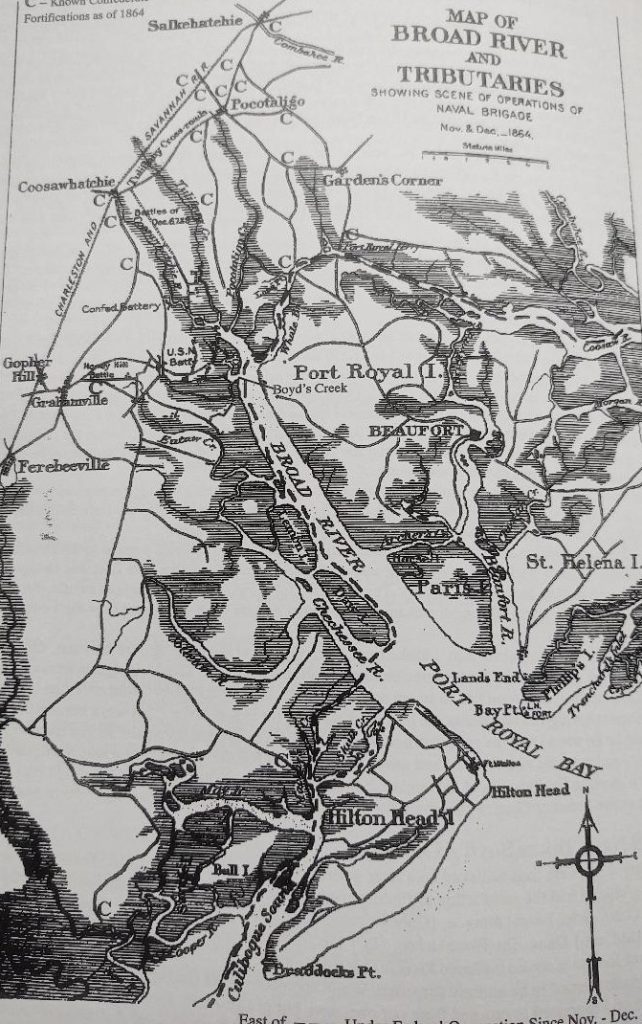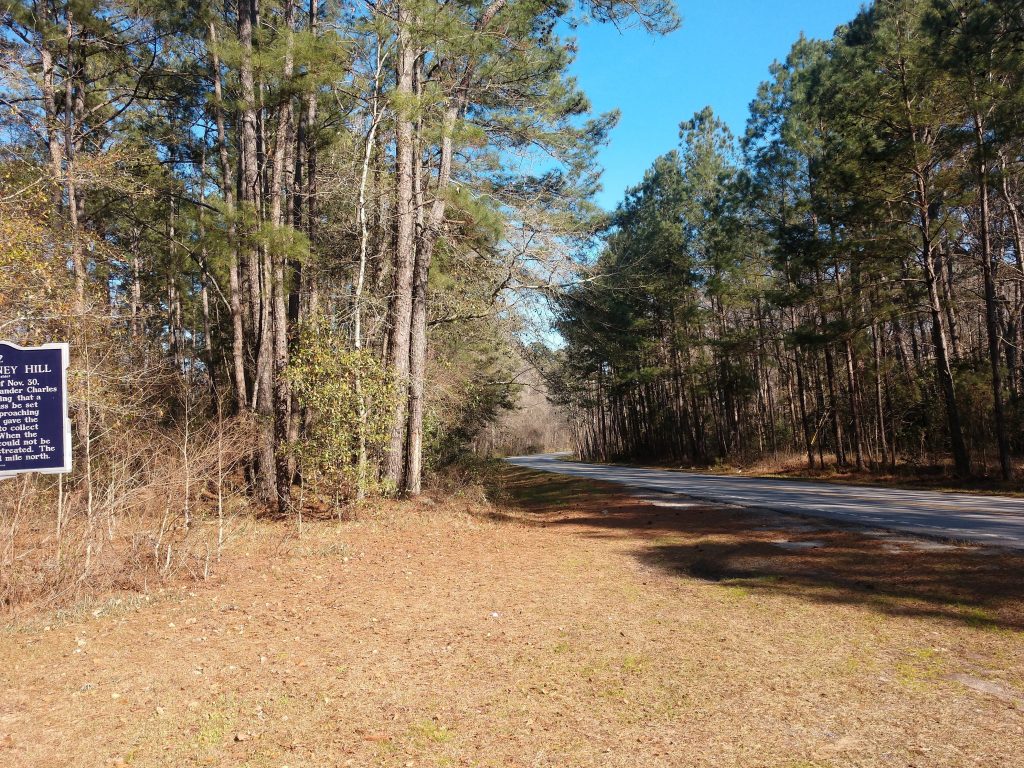The War in the Lowcountry: Part II: The Battle of Honey Hill
In November 1864, General William T. Sherman, whose forces were closing in on Savannah, requested that the railroad be attacked again to prevent reinforcements from reaching the Georgia city ahead of his troops. As in 1862, the target was the vital Charleston and Savannah railroad, this time at Grahamville, SC, near modern Ridgeland.
Gen. John P. Hatch commanded the Coastal Division, which occupied the coastal and sea islands of South Carolina, including Hilton Head and Beaufort. The strike force he assembled included two infantry brigades and a naval brigade composed of sailors and marines. Artillery, including boat howitzers manned by sailors rounded out the force. Consisting of about 4,000 men, they departed Hilton Head Island on November 29.

At strategic points along the railroad line, especially bridges, the Confederates had built earthworks. Often unmanned, they could quickly be occupied when needed. It was similar to the defense works around Richmond, which were largely unmanned but could be occupied when threatened. This mobile defensive strategy, with prepared fixed positions, would prove to be effective.
Gen. G. W. Smith, who had taken over at the 1862 battle of Seven Pines when Gen. Joseph E. Johnston was wounded, commanded Confederate forces in the area. The immediate neighborhood forces were led by Gen. Samuel Jones. His force would be about 2,000 men from Georgia milita, two Georgia regiments, the 3rd South Carolina Cavalry, and arsenal workers from the Athens and Augusta arsenals, in all about 2,000 arrived at honey Hill.
The Union forces arrived at Boyd’s landing on the Broad River, about five miles from their target, and began moving inland, delayed by Confederate pickets. In the meantime, at Honey Hill, Jones prepared to make his stand. This ridge extended parallel to and in font of (east of) the railroad line. Reinforcements could easily reach him here and the terrain was well suited for defense. The hill overlooked swampy ground to the east and thick woods, where the Federals would have to approach. One lone road ran through the area, towards Grahamville and the railroad line. In addition, the defenders had measured the distance in front of their guns so they could accurately time the fuses on their shells.
November 30th saw both sides move towards Honey Hill. Union forces advanced from their campsites, and local Confederate forces concentrated at the hill. Reinforcements from Georgia were soon arriving too by rail. Col. Charles Colcock, commanding the 3rd South Carolina Cavalry, ordered the grass field in front of his line at the hill to be set on fire. The wind blew the smoke toward the Union troops, and the wall of flame disrupted their movement and vision. General Smith arrived on the scene but let Colcock continue in command as he knew the ground.
Union troops approached at 11 a.m. and the battle began. Hatch’s troops arrived piecemeal, and they entered the battle that way. The 157th, 56th, and 127th New York, 55th Massachusetts, 25th Ohio, and the Naval Brigade advanced against the Confederate line. General E.E. Potter, commanding the first brigade, oversaw this advance. The terrain was so wooded that the federal artillery could only deploy on the road. As they closed in, the attackers struggled through dense undergrowth, interlacing vines, and faced enemy sharpshooters.

The 25th Ohio and 32nd USCT (from Philadelphia) struck on the right, attacking through swampy ground, but failing to make any headway. The 55th Massachusetts (another colored unit and sister to the 54th) made three charges, all of which failed. They Union soldiers faced intense fire, could not return fire effectively themselves, and lacked the numbers to overwhelm the entrenched defenders.
The 144th New York, 54th Massachusetts, and Marine Battalion then came up and joined the fray. The additional troops could not force a breakthrough. None of the various attacks that day were coordinated.
The Union artillery fired so much it ran out of ammunition and was replaced by the naval battery, manned by sailors. Battery F of the 3rd New York Artillery had many men wounded, and two ammunition chests hit and exploded.
Col. Charles Fox of the 55th Massachusetts wrote, “During the afternoon, the infantry fire between the two lines still invisible to each other, but at times only fifty yards apart, was often very hot . . .” Unable to force the position, and unable to flank it due to the swampy terrain, Hatch pulled back. First the Union left withdrew, then the Union right. In the rear the wounded were loaded onto ambulances, and soldiers improvised stretchers from muskets and blankets. By dusk the entire force was pulling back. A Confederate band played “Funeral March” by Beethoven as the Union forces retreated.
It was a frustrating and costly failure. Maj. E.C. Culp of the 25th Ohio vented, “Thus ended the battle of Honey Hill, fought without a plan, without commanding officers near enough to give intelligent orders, at the will of regimental commanders, and most of them too timid or cowardly to use decent judgment.” He went on to say that had they been better organized, the troops would have “swept over Honey Hill and regarded it as a joke.”
Capt. Charles C. Soule, 55th Massachusetts agreed, saying, “It is only fair to say that the Confederates management seems to have been excellent from first to last. On their side it was all good generalship and good luck, on ours it was the reverse.”
Southern soldier Joseph T. Derry noted, “A remarkable feature of this battle was the presence among the Confederates of some boy volunteers, even under the age subject to conscription [16 years old]. Soldiers who were present in that battle say that some of these boys were not tall enough to shoot over the parapet. So they resorted to the following device: a boy would get on his hands and knees, another would stand upon his back, deliver his fire, and then change places with his friend . . .”
General Potter explained, “Exposed to a heavy fire from a concealed enemy who was strongly entrenched, and laboring under every disadvantage of ground, they maintained their position with the greatest tenacity and endurance. Nothing but the formidable character of the obstacles which they had to encounter prevented them from achieving success.” No doubt the words were not reassuring to the men who endured the long march, difficult terrain, and combat.
General John Foster, commanding the Department of the South, wrote, “After an obstinate fight of several hours, General Hatch, finding that the enemy’s line could be neither successfully assaulted nor outflanked, retired after dark . . .”
The result of this failed expedition was 754 Union and 90 Confederate casualties. The Union expedition had unwisely struck at one of the best prepared defensive positions along the railroad line, where smaller numbers were multiplied by earthworks. Poor terrain limited visibility and the ability to maneuver or use artillery effectively.
Today Honey Hill’s earthworks are in remarkable shape. The site is private property, but a historic marker is located at the center of the battlefield on Route 366, the old wartime road. It is just off I-95 near Ridgeland, SC.